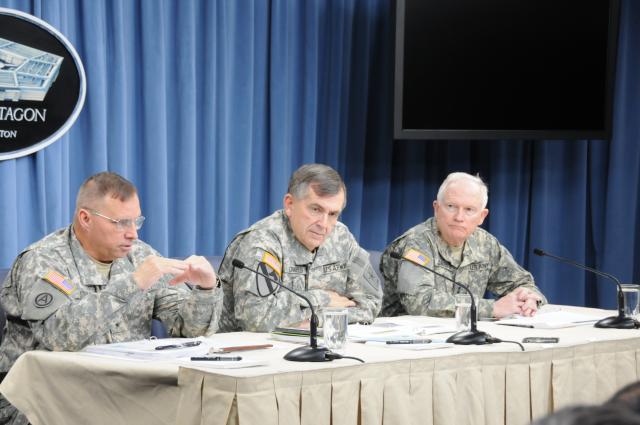The Army vice chief of staff reported a slight reduction this past year in suicides committed by Soldiers on active duty, from 162 in 2009 to 156 in 2010.
“While we achieved modest success in reducing the number of suicides of these Soldiers on active duty,” said Gen. Peter W. Chiarelli, “we saw a significant increase in the number of suicides of Soldiers not serving on active duty, to include a doubling in the Army National Guard.”
In 2009, the number of Guard and Reserve Soldiers who committed suicide while not serving on active duty was 80. In 2010, that number nearly doubled to 145.
“In 2010, we’ve got two obvious questions: first of all what happened and second, we have to be able to respond and tell people what we are doing about it,” Maj. Gen. Ray Carpenter, acting director of the Army National Guard, said.
According to Carpenter, the analysis for 2010 shows that it’s not a deployment problem, because more than 50 percent of the people who committed suicide in the Army National Guard had never deployed. It’s not a problem of employment, because only about 15 percent of the people who committed suicide in fact were without a job.
“As you look at it, part of it is a significant relationship problem, because over 50 percent of those who committed suicide had some sort of a partner problem that they were dealing with whether it was marriage, divorce, or boyfriend, girlfriend, that kind of thing. Our effort is to build resiliency in Soldiers,” Carpenter said.
To help understand the factors involved with suicide, the Army has partnered with the National Institute of Mental Health on a program called Army STARRS.
Army STARRS, the Army Study to Assess Risk and Resilience in Servicemembers, was officially launched in late 2008.
Over the course of the five-year study, to run through 2014, and by working with up to 400,000 Soldiers, NIMH and the rest of the research team – including the Uniformed Services University of the Health Services, University of Michigan, Harvard University and Columbia University – hope to identify the risk and protective factors that affect a Soldier’s psychological resilience, mental health, and potential for self-harm.
“When you realize that we’re taking a young American in the Army today, psychologists will tell you, in six years in the U.S. Army under the OPTEMPO that we’re on right now, we’re putting them under as much stress in a six-year period as they would have if they lived to be 80 years old in Seattle, Washington, and whatever they did there,” Chiarelli said.
Col. Chris Philbrick, deputy director of Army Health Promotion, Risk Reduction Task Force, said in an earlier release that research and analysis of the suicide cases of this past year continue to reinforce that there are no universal solutions to address the complexities of personal, social and behavioral health issues that lead to suicide within the Army.
“The positive thing I see is that some of our programs are beginning to work, but more important than anything else, our leaders are fully engaged with this problem right now. We’re getting at the stigma issue, we’re getting people the help that they need and I hope you’re going to see these numbers go down significantly in the coming year,” Chiarelli said.
Suicide is the fourth-leading cause of death among 25- to 44-year old people in the United States. Historically, the suicide rate has been lower in the military than among civilians. In 2008 that pattern was reversed, with the suicide rate in the Army exceeding the age-adjusted rate in the civilian population (20.2 out of 100,000 vs. 19.2).
While the stresses of the current wars, including long and repeated deployments and post-traumatic stress, are important potential contributors for research to address, experts point out that suicidal behavior is a complex phenomenon.
The study will examine a wide range of factors related to and independent of military service, including unit cohesion, exposure to combat-related trauma, personal and economic stresses, family history, childhood adversity and abuse, and overall mental health.
“I really believe when we put more time between deployments that is going to be a huge factor in helping get at a lot of these problems,” Chiarelli said. “I really believe that dwell is one of the things we have to look at, and has an impact on all kinds of problems, not just suicides, but you know, all the things that fall short of suicide from relationship issues to drug and alcohol abuse, to high-risk behavior, to all those things. The more time we can get between deployments, the better off we’ll be.”
Soldiers and families in need of crisis assistance can contact the National Suicide Prevention Lifeline. Trained consultants are available 24 hours a day, 7 days a week, 365 days a year and can be contacted at 1-800-273-TALK (8255) or by visiting the website at http://www.suicidepreventionlifeline.org.
The Army’s comprehensive list of Suicide Prevention Program information is located at http://www.preventsuicide.army.mil.
Army leaders can access current health promotion guidance in newly revised Army Regulation 600-63 (Health Promotion) at: http://www.army.mil/usapa/epubs/pdf/r600_63.pdf and Army Pamphlet 600-24 (Health Promotion, Risk Reduction and Suicide Prevention) at http://www.army.mil/usapa/epubs/pdf/p600_24.pdf.
Suicide prevention training resources for Army Families can be accessed at http://www.armyg1.army.mil/hr/suicide/training_sub.asp?sub_cat=20 (requires Army Knowledge Online access to download materials).
Information about Military OneSource is located at http://www.militaryonesource.com or at the toll-free number 1-800-342-9647 for those residing in the continental United States. Overseas personnel should refer to the Military OneSource website for dialing instructions for their specific location.
Information about the Army’s Comprehensive Soldier Fitness Program is located at http://www.army.mil/csf/.
The Defense Center for Excellence for Psychological Health and Traumatic Brain Injury outreach center can be contacted at 1-866-966-1020, and via electronic mail at http://www.dcoe.health.mil .
The website for the American Foundation for Suicide Prevention is at http://www.afsp.org/, and the Suicide Prevention Resource Council site is found at http://www.sprc.org/index.asp.










